Update: Tathya has an article and pictures on the current status of the construction of AIIMS Bhubaneswar. One of the pictures is given below. Tathya.in says: "Kolkota based Unit Construction has taken up the construction job, while the PSU, Hospital Services Consultation Corporation (HSCC) is the civil consultant for this projects."
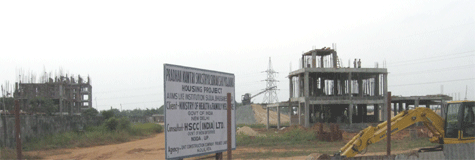
More details on the tender is at http://mohfw.nic.in/Index6aiims.htm:
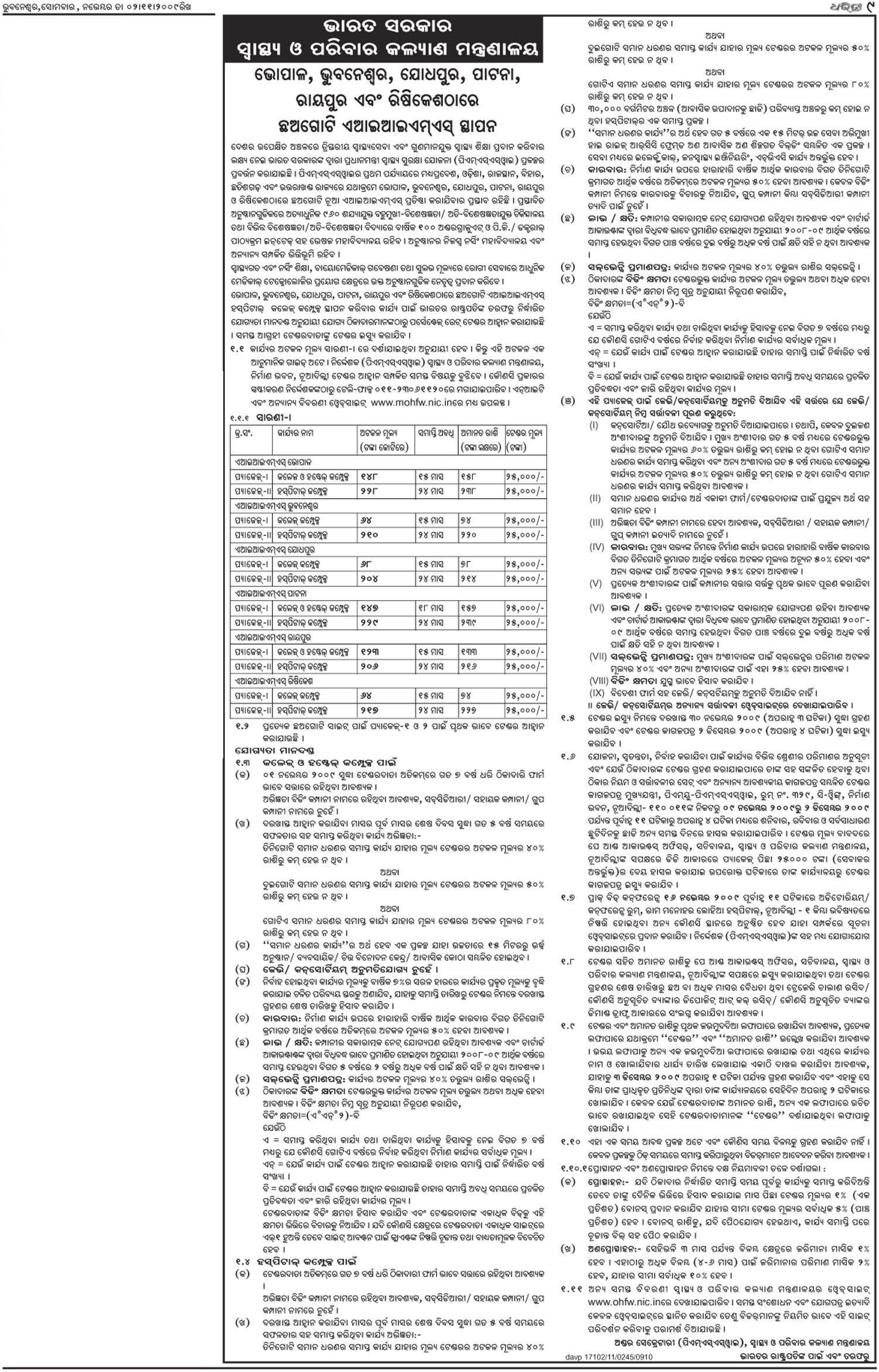
The above tender is about the hospital and medical college. Earlier in May 2008, tenders were floated for the housing complex. See https://www.orissalinks.com/archives/1121. (Even older links related to tenders for the AIIMS-like institution in Bhubaneswar are at https://www.orissalinks.com/?p=970.) In June 2009 it was reported that:
- Out of the 14 blocks of the AIIMS, the roof works of eight blocks have already been completed.
- An alternative road has already been constructed for the Sijua village and 90 per cent work has already been completed.
- Steps have been taken to remove the high-voltage transmission line.
I hope additional progress has been made with respect to the housing construction.
November 2nd, 2009
IISc Bangalore faculty Prof. Abi has a nice article on this in the IIT Kharagpur student magazine Scholar’s avenue. Following are some excerpts arranged as bullet points.
- Salary: Going by the present, post-SPC salaries, you’ll start as an assistant professor at Rs. 6 lakhs, at the end of your career, you’ll be at over 12 lakhs.
- ‘benefits’: allowances (house rent, transport, telephone and internet), social security contributions (pension or provident funds, career-end bonus, etc) and perks (medical insurance, leave travel concession, for example). The value of these benefits could easily exceed 50 percent of the salary.
- consulting: It can give you the satisfaction of solving some real world problems. It can be a great source of ideas for long term research. Most importantly, it also has the highly desirable property of giving you some extra cash!
- IIX salary is not only fully protected, it’ll also (a) keep up with inflation, (b) keep rising (through annual increments) and (c) see substantial jumps every decade or so. To sweeten things even more, IITs are planning to introduce incentives to reward extraordinary performance (and I’m sure other IIXs will follow suit).
- As an IIX faculty member, you’ll enjoy a couple of features that are not available to engineers and managers in industry (in both public and public sectors): two (or even three) months off every summer and a one-year sabbatical leave every seven years.
- As an IIX faculty member — and this may come as a surprise to you — you’ll also enjoy certain advantages over faculty in US universities.
- First, you don’t have to pay your graduate students, the government pays them.
- More importantly, the same research idea has a far higher probability of getting funded in India than in the US. This means that you’ll spend more of your time on actually doing research, than on writing grant applications seeking that ever-elusive funding.
- Finally, the autonomy, the choice and the flexibility: As an IIX faculty member, you’ll probably spend 30 to 40 percent of your time in teaching and related activities. The remaining time is yours, and yours alone — nobody tells you how to spend it. You could use it for research (for getting peer recognition), teaching (for your students’ adulation), and consulting (for money, and collaboration with industrial partners). There are other academic pursuits as well: writing books and popular science articles, teaching kids in local schools and colleges, learning about new and emerging fields, etc.
November 2nd, 2009
The following list of state agricultural universities is compiled from the information in http://www.icar.org.in/?q=universities.htm. This list is also available at the pages of Indian Agricultural Universities association.
Andhra Pradesh
- Acharya NG Ranga Agricultural University, Hyderabad
- Sri Venkateswara Veterinary University, Tirupati
Assam
- Assam Agricultural University, Jorhat
Bihar
- Rajendra Agricultural University, Pusa, Samastipur
Chhatisgarh
- Indira Gandhi Krishi Vishwavidyalaya, Raipur
Gujarat
- Anand Agricultural University, Anand
- Junagadh Agricultural University, Junagarh
- Navsari Agricultural University, Navsari
- Sardarkrushinagar-Dantiwada Agricultural University, Bansakantha
Haryana
- Chaudhary Charan Singh Haryana Agricultural University, Hisar
Himachal
- CSK Himachal Pradesh Krishi Vishvavidyalaya, Palampur
- Dr Yashwant Singh Parmar Univ of Horticulture & Forestry, Solan
J & K
- Sher-E-Kashmir Univ of Agricultural Sciences & Technology, Jammu
- Sher-E-Kashmir Univ of Agricultural Sciences & Technology of Kashmir, Srinagar
Jharkhand
- Birsa Agricultural University, Ranchi
Karnataka
- University of Agricultural Sciences, Bangalore
- University of Agricultural Sciences, Dharwad
- Karnataka Veterinary, Animal and Fisheries Sciences University, Bidar
Kerala
- Kerala Agricultural University, Trichur
Madhya Pradesh
- Jawaharlal Nehru Krishi Viswavidyalaya, Jabalpur
Maharashtra
- Dr Balasaheb Sawant Konkan Krishi Vidyapeeth, Ratnagiri
- Dr Panjabrao Deshmukh Krishi Vidyapeeth, Akola
- Maharashtra Animal Science & Fishery University, Nagpur
- Mahatma Phule Krishi Vidyapeeth, Rahuri
- Marathwada Agricultural University, Parbhani
Orissa
- Orissa Univ. of Agriculture & Technology, Bhubaneswar
Punjab
- Guru Angad Dev Veterinary and Animal Science University, Ludhiana
- Punjab Agricultural University, Ludhiana
Rajasthan
- Maharana Pratap Univ. of Agriculture & Technology, Udaipur
- Rajasthan Agricultural University, Bikaner
Tamil Nadu
- Tamil Nadu Agricultural University, Coimbatore
- Tamil Nadu Veterinary & Animal Science University, Chennai
UP
- Chandra Shekar Azad University of Agriculture & Technology, Kanpur
- Narendra Deva University of Agriculture & Technology, Faizabad
- Sardar Ballabh Bhai Patel Univ. of Agriculture & Technology, Meerut
- UP Pandit Deen Dayal Upadhaya Pashu Chikitsa Vigyan Vishwa Vidhyalaya evam Go Anusandhan Sansthan, Mathura
Uttaranchal
- Govind Ballabh Pant University of Agriculture & Technology, Pantnagar
West Bengal
- Bidhan Chandra Krishi Viswavidyalaya, Kalyani
- Uttar Banga Krishi Viswavidyalaya, Cooch Bihar
- West Bengal University of Animal & Fishery Sciences, Kolkata
Manipur
- Central Agricultural University, Imphal
The Indian Agricultural Universities association also includes the following deemed universities,
and the following university that has programs in Agriculture
October 26th, 2009
Regardless of the attempt to industrialize Orissa, for a long time to come a large number (perhaps majority) of people in Orissa will still use agriculture for their livelihood. Also various reports mention that Agriculture is the top focus of the current government in Orissa. With that in mind, I am thinking to push for a second Agricultural University in Orissa. Many other states already have more than one agricultural university. (See the lists here, here, the ICAR list and the wikipedia entry.) I would like feedback on what would be a good location for the second Agricultural University in Orissa.
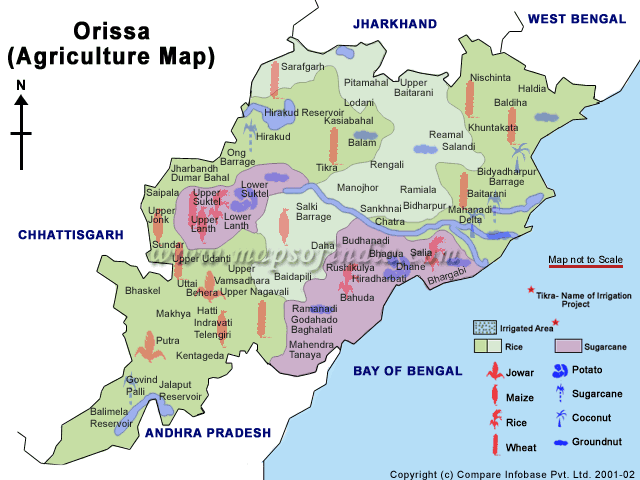
My initial instinct says Bhawanipatna/Kesinga, as I have heard about Kalahandi’s agricultural potential; also that location creates a good geographical balance. That was probably one of the main reasons the government earlier announced an agricultural college in Bhawanipatna. If I could get some more supporting data and arguments I would like to push that the proposed agricultural college in Bhawanipatna be made into a university and become the second Agricultural University in Orissa.
October 26th, 2009
.jpg)
IIT Bhubaneswar has unveiled a new web page. It looks very good. Based on the information there it currently has 16 regular faculty in its five schools including the Director. They are:
- School of Basic Sciences
- Sujit Roy, Professor & Head, Chemistry, PhD, 1987, IIT Kanpur
- Srikanta Patra, Assistant Professor, Chemistry, PhD, 2005, IIT Bombay
- Sabyasachi Pani, Assistant Professor, Mathematics, PhD, 2004, IIT Kharagpur
- Rajan Jha, Assistant Professor, Physics, PhD, 2007, IIT Delhi
- Snehasis Chowdhuri, Assistant Professor, Chemistry, PhD, 2005, IIT Kanpur
- Akshay Kumar Ojha, Assistant Professor, Mathematics, PhD 1997, Utkal University
- School of Electrical Sciences
- Ganapati Panda, Professor & Head, PhD, 1982, IIT Kharagpur
- Prasant Sahu, Assistant Professor, PhD 2009, IIT Kharagpur
- Debalina Ghosh, Assistant Professor, PhD 2008, Syracuse University
- School of Infrastructure
- Sekhar Dutta, Professor & Head, PhD, 1982, IIT Kharagpur
- P. Dinakar, Assistant Professor, PhD, 2008, IIT Madras
- Puspendu Bhunia, Assistant Professor, PhD, 2008, IIT Kharagpur
- Sumanta Haldar, Assistant Professor, PhD, 2008, IISc Bangalore
- School of Mechanical Sciences
- Madhusudan Chakraborty, Director and Professor, PhD, 1978, IIT Kharagpur
- Swarup Mahapatra, Associate Professor & Head, PhD 2000, Jadavpur University
- Prasenjit Rath, Assistant Professor, PhD 2007, NTU Singapore
- Satyanarayan Panigrahi, Assistant Professor, PhD 2007, IISc Bangalore
- School of Social Sciences & Humanities
October 24th, 2009
Following is an excerpt from a report in India Journal.
The government of India is planning to establish 10,000 Industrial Training Institutes (ITIs) in rural areas across the country for imparting technical training to youths.
Minister of State for Planning V Narayanasamy announced this while inaugurating the first national convention of rural institutes, organized by the National Council of Rural Institutes, here Oct 19.
“We have opened the flood gates for foreign investment in the education sector. Our thrust is on expanding the educational infrastructure in the rural areas by opening more institutes and universities,” the minister said.
He said plans were afoot to set up one rural university in each backward and tribal clusters across the country. Besides, 25,000 schools would also be set up in rural areas under the Public-Private Partnership mode.
Some of the existing Rural Universities in India are:
Looking for the "New Education Policy of the Nation reflects the principles evolved here in developing the rural university concept " I came across the document at http://www.ncri.in/html/english%20finacial%20guidlines.pdf which mentions this policy, but this policy was made in 1986 and revised in 1992. There is no mention of "Rural Universities" in the 11th plan. I guess the minster’s staement above may be referring to the upcoming 12th plan. If that is the case, it is a great idea to pursue it now.
If indeed as the minsiter says, a rural university is established in each backward and tribal clusters across the country Orissa could go after at least 3 such universities: one in the KBK district cluster, one in the Gajapati-Kandhamal district cluster and one in Sundergarh-Mayurbhanj-Keonjhar district cluster. In this regard we must watch out the pages of the National Council of Rural Institutes.
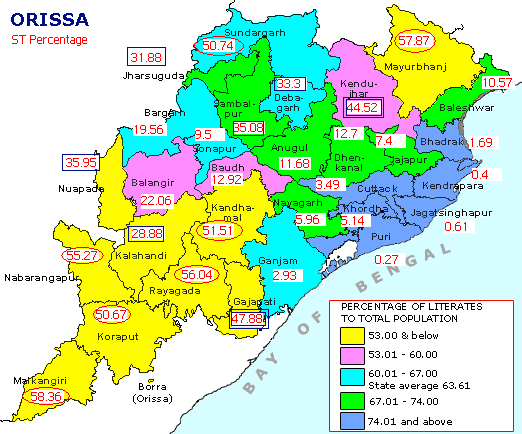
October 23rd, 2009
The following is from Samaja e-paper. (Sambada also reports on this.)
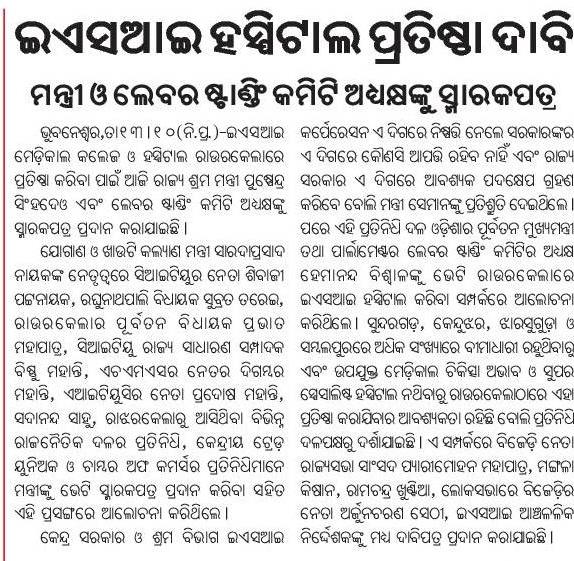
I think the situation is clear. All the biggies from Rourkela, including MLA and minister from Rourkela Mr. Sarada Nayak, are now publicly united on this. The Orissa government does not seem to have any opposition except that they don’t want to lose it out of Orissa. So what is needed is an indication from the center that they do not mind having it in Rourkela. However, such an indication needs to come very soon as other reports still mention about progress with respect to the Bhubaneswar location. (See also this report in expressbuzz.com.)
October 14th, 2009
Following is from Samaja.
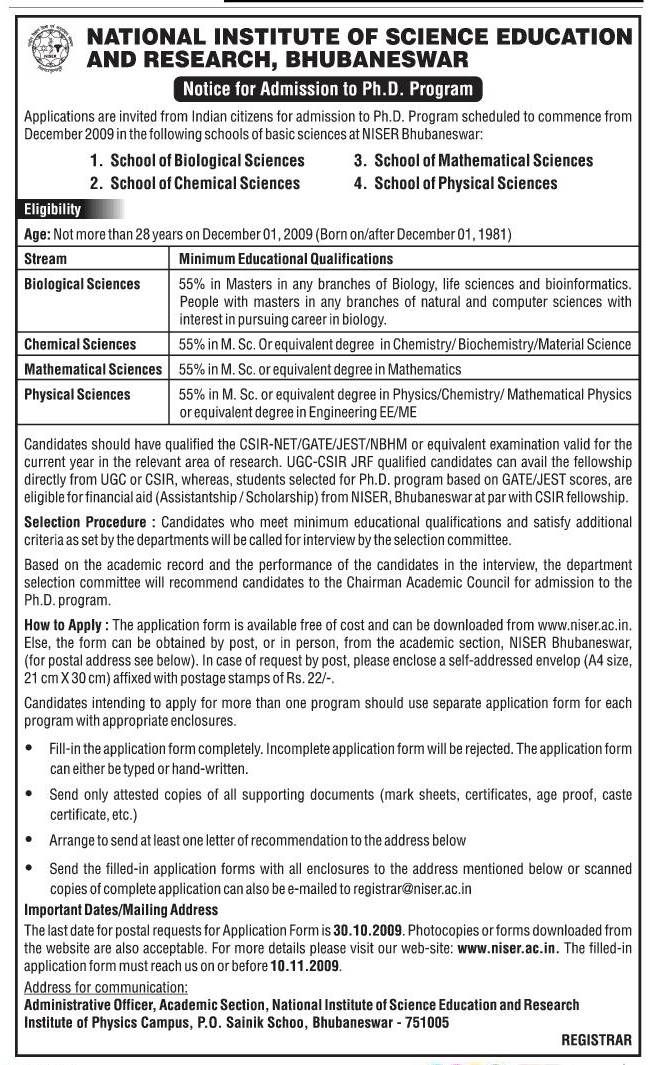
October 8th, 2009
Update: Various trade unions and local organizations in Rourkela have signed a joint memorandum. The details are at: http://www.odiasamaja.org/esic-medical-college-trade-unions-variour-organizations-support/.
Following is an excerpt from a report in Pioneer.
Hundreds of e-mails reached the Chief Minister’s Office (CMO) urging him to impress upon the Employees’ State Insurance Corporation (ESIC) for establishment of the college and hospital in the steel city. The Prime Minister and the Union Minister for Labour were flooded with mails and memorandums. Bur it seems nobody in the Government is bothered about the hue and cry raised by the people from various sections of the society.
“If there is any place fit for an ESIC Medical College & Hospital, it is Rourkela,” said a top Orissa Government official. Then how come the Government is silent over the demand and has allowed the ESIC to set up the college and hospital in Bhubaneswar? “You better ask the Chief Minister,” said the officer on the condition of anonymity. Now, as the ESIC has been allotted land on the outskirts of the capital city, chances of Rourkela seem remote, admitted the official.
Interestingly, when the people of Rourkela joined the bandwagon for demanding the medical college and hospital in the steel city, local MLA Sarada Prasad Nayak, who is the Minister for Food, Civil Supplies and Consumer Welfare remained silent. Similarly, Minister for Labour and Employment Puspendra Singh Deo, who also hails from Western Orissa, quietly favoured the college to come up in Bhubaneswar.
The ESIC will spend Rs 600 crore for the medical college and hospital, a dental college and a nursing college in the same campus, said sources. Officials point out that as there is no full-fledged airport near Rourkela, the Centre will not agree to setting up of a medical college there.
The mention about Rourkela not having airport and hence center may not agree is bogus. I don’t see any connection betweem an airport and an ESIC medical college. Indeed two other locations where ESIC medical colleges are being established do not have a nearby airport either. They are Gulbarga, Karnataka and Alwar, Rajasthan. (Thanks to Prashant babu for pointing to the second one.)
October 5th, 2009
Update: The following was written before I saw this article in Pioneer.
Tathya.in has a report on Dr. Digamabara Patra’s request for a national or central university in Bhawanipatna, Kalahandi. A lot of the arguments made there make sense. Many of the recent central universities have been established in rural and semi-urban areas and indeed there is no reason why one should not be established in Bhawanipatna; especially since its citizens have been asking for one for more than 2 decades.
However, as mentioned in the article https://www.orissalinks.com/archives/3229 adequate infrastructure seems to have been an important factor in determining the locations of the new IITs, IIMs and National universities.
For Orissa to have them in locations ouside of Bhubaneswar, there are two ways to go about it.
- Argue that adequate infrastructure should not be a requirement or they will automatically come once the institutions are established.
- Develop areas outside Bhubaneswar to have adequate infrastructure.
To me pursuing (2) has a higher chance of success than pursuing (1) and even if (1) is successful the institutes/universities in locations without appropriate infrastructure will struggle until the infrastructure eventually catches up which may take a long time if just left to fate. (Such a struggle may result in Orissa not being given in appropriate numbers additional central/national institutes.)
[In India people sometime point out that IIT Kharagpur was established in a rural location. First, Kharagpur is only 116 kms from Howrah. Second it has been a major railway junction for a long time. Third it was the first IIT and for a long time only one of 5 IITs. Similarly Roorkee was the oldest engineering college and is close to Haridwar and Dehradun. There are a few top universities and institutions in the US that are in rural areas, but these are exceptions, and the infrastructure in rural areas of US are quite good compared to rural areas of India. For example, Univ of Illinois at Urbana Champaign and Penn State University in State College, PA are often mentioned in that context. But both do have small airports with commercial flights.]
Before we suggest what needs to be done regarding developing areas outside Bhubaneswar to have adequate infrastructure, let us address what may be coming in the future and why Orissa needs to do this urgently so as to not risk missing future allocations of national institutions.
The National Knowledge Commission (NKC) in its December 2006 note on higher education has explicitly suggested 50 national universities in India. It says:
We recommend the creation of up to 50 National Universities that can provide education of the highest standard. As exemplars for the rest of the nation, these universities shall train students in a variety of disciplines, including humanities, social sciences, basic sciences, commerce and professional subjects, at both the undergraduate and post-graduate levels. The number 50 is a long term objective. In the short run, it is important to begin with at least 10 such universities in the next 3 years. It is worth noting that the National Universities need not all be new universities. Some of the existing universities could also be converted into National Universities, on the basis of rigorous selection criteria, to act as exemplars. We recognise that there could be a human resource constraint if faculty members are not available in adequate numbers to establish these universities.
The current government has implemented most of the recommendations of the NKC and exceeded some of them. For example, instead of the recommendation of 10 national universities in the three years following the report (2007-2010), establishment of 14 have been announced. Moreover, the higher education budget has been increasing drastically from one five year plan to the next. The 12th five year plan starts in 2012 and it is expected that it will take up on the long range objectives of the knowledge commission. In other words there could and should be more central and national universities in the 12th plan.
[My impression is that how soon additional national universities are established will depend on the success of the first 14. It seems to me that the locations of the first 14 have been greatly influenced by the consideration of, where in each of the states selecetd, does it have the best chance to succeed.]
Unless Orissa is prepared for it, Orissa may lose out pieces of those plans on lack of infrastructure grounds. Other states with multiple locations with adequate infrastructure will get preference and Orissa may lose out.
However, 2012 is still 3 years away and if adequate steps are taken very soon, Orissa should be able to get its fair share.
The pity is there are areas in Orissa which are on the verge of having the necessary infrastructure, mostly through private investment, but because of non-constructive opposition, blind suspicion towards industrialization and the relcucatnce of many to speak out in favour of development and industrialization, the development and associated infrastructure building has been greatly hampered. The governments (state and center) are also at fault for their sluggishness on some aspects.
Following are some suggestions:
- The state government should push for the completion of the airport in Jharsuguda within a year.
- It should make an all-out effort to have commercial flights operating out of the existing airport in Rourkela. In general, the people of the area need to recognize the existing infrastructure and potential of Rourkela and take advantage of it. Currently, as a friend of mine would say, Rourkela is an orphan. This is a pity. It is a big asset to Orissa, especially to the western parts of Orissa; but is severely underutilized and undermined.
- Coming back to Jharsuguda, the people there should follow a smarter approach in not opposing and rather facilitating industries coming up there, and at the same time being vigilant about environmental and land acquisition related R & R issues. If these industries and investment are allowed to materialize there soon, then Sambalpur-Jharsuguda area would become a large metro with adequate infrastructure to have and support any and all kinds of institutes and universities. But will the people do that? Or will they continue to be controlled by or scared of the anti-industry activists.
- Similarly, both Bhawanipatna (Lanjigarh to be precise) and Rayagada areas have industrial investors who have been senselessly opposed. If the people would take a smarter approach that mixes development with being vigilant about environmental and land acquisition related R & R then both these areas would be able to get infrastructure where a central university (and possibly more) would flourish. But will the people do that? Or will they continue to be controlled by or scared of anti-industry activists. In Lanjigarh, Kalahandi, the local MP has recently taken a more sensible approach. I hope there is a quick resolution as this area desperately needs development and the resulting infrastructure.
- The state government should push for the rail infrastructure, particularly, the Khurda-Balangir line, the Talcher-Bimlagarh line and connectivity to Kalahandi, to be completed at the earliest.
The above is extremely important for the development of the western parts of Orissa where there is often a feeling of neglect. If the people there do not follow a smarter approach and only follow the strange approach that many (not all) seem to be following (such as opposing industrialization and thus infrastructure building but wanting things that need infrastructure) the places that follow a smarter approach (inside and outside Orissa) would be gainers. The same is happening in some other places in Orissa too – Paradeep and Kalinganagar come to mind, but these places are in closer proximity to Bhubaneswar and because of that they may be less harmed.
October 4th, 2009
Update on 27th April 2011: The Central University location has been changed to Bander Sindri near Ajmer and only 80 kms from Jaipur. The Innovation University (previsouly referred to as National University) aiming for world class is now pushed for Jaipur. [Times of India].
Tathya.in has a report that mentions some official saying that because of the lack of an airport in Rourkela central government will not agree to have ESIC medical college in Rourkela. I think this is a completely frivolous argument; I don’t see much connection between an ESIC medical college and an airport. (Often airport is a codeword for adequate infrastructure. If that is the case Rourkela indeed has the infrastructure for an ESIC medical college.)
However, in regards to certain centrally funded institutions, such a requirement is in the background and mentioned by journalists, even if they may not be spelled out explicitly. So while pushing for an ESIC medical college in Rourkela, we should set our target to push for more functioning airports as a next action item. Following is a more detailed analysis.
Given below are the locations of some national institutions and some related attributes. It is easy to see that for the locations of IITs, IIMs and National Universities being near (say within 120 kms or 2 hrs) an operational airport has been an important factor. For national universities, in addition being in a large (1 million plus metropolitan area) area with other research institutes has also been spelled out as an important criteria and it is reflected in the locations that are picked.
On the other hand, the newly established central universities are in towns of all sizes and the locations of the NITs are mixed. The next level centrally funded but locally focused technological institutes, SLIET, Longowal, ABAGKC IET, Malda and Central Institute of Technology, Kokrajhar are on purpose established in rural areas and smaller towns. Unlike the NITs these institutions take only local students and also have programs focused on local needs. Nevertheless, their quality need not be bad. For example, SLIET is considered quite good.
Looking to the future following are some points relevant to Orissa.
- For Orissa to have future central institutions like IIM, SPA, etc. to be in a location outside of Bhubaneswar, Orissa must push for the quick establishment of airports and other infrastructure in other parts of the state. For example, the airports in Jharsuguda and Rourkela are the closest to be operational and they should have scheduled flights at the earliest. Otherwise new centrally funded institutions may again be established near Bhubaneswar and crying hoarse after the fact may not be productive.
- Similarly the knowledge commission has proposed the establishment of 50 national universities in the long run. Considering that the education budget significantly increases from one 5 yr plan to the next, I would not be surprised if there is another set of them made during the 12th plan. Orissa must be prepared for that and by that time (there is a short window) have other areas in Orissa with adequate infrastructure that are being deemed necessary for a national university.
- Orissa must take advantage of the industrial and investment interests in Orissa, mostly due to its minerals, and develop metropolitan areas with larger population base. Currently the local people are creating roadblocks rather than helping in such development.
- In 2010 we should do our best to convince the planning commission, the PM and MHRD that the 12th plan (starting 2012) should include more centrally funded institutions of the kind that can be located in rural or semi-urban areas. In particular,
- A centrally funded but locally focused technological institute (like SLIET) in all states. The one in Orissa could be located in Kalahandi or Balangir, the other two KBK districts that lack centrally funded institutions.
- Two regional universities in each major states that are funded 50-50 by the state and the center. (This would be better than one centrally funded institute.)
- Multiple branches of Indira Gandhi National Tribal University in districts with high tribal population.
The NITs.
| City/Town |
State |
Population of city/town |
Population rank |
| Delhi |
Delhi |
18,639,762 |
2 |
| Surat |
Gujarat |
3,196,799 |
10 |
| Jaipur |
Rajasthan |
3,102,808 |
11 |
| Patna |
Bihar |
2,656,318 |
13 |
| Nagpur |
Maharashtra |
2,569,775 |
14 |
| Bhopal |
MP |
1,751,766 |
17 |
| Allahabad |
UP |
1,272,612 |
31 |
| Jamshedpur |
Jharkhand |
1,252,815 |
33 |
| Srinagar |
J & K |
1,104,489 |
41 |
| Calicut |
Kerala |
1,000,802 |
46 |
| Tiruchirapalli |
Tamil Nadu |
963,237 |
49 |
| Jalandhar |
Punjab |
958,854 |
50 |
| Raipur |
Chhatisgarh |
795,104 |
56 |
| Dehradun |
Uttarakhand |
738,889 |
57 |
| Warangal |
Andhra Pradesh |
656,298 |
61 |
| Surathkal, Mangalore |
Karnataka |
612,374 |
66 |
| Pudducherry |
Pudducherry |
575,027 |
71 |
| Rourkela |
Orissa |
550,668 |
75 |
| Durgapur |
West Bengal |
543,922 |
77 |
| Shillong |
Meghalaya |
304,596 |
136 |
| Aizawl |
Mizoram |
295,864 |
140 |
| Imphal |
Manipur |
279,679 |
147 |
| Agartala |
Tripura |
218,028 |
184 |
| Silchar |
Assam |
209,543 |
193 |
| Kurukshetra (Thaneswar) |
Punjab |
157,609 |
249 |
| Panaji |
Goa |
142,336 |
271 |
| Kohima |
Nagaland |
103,210 |
407 |
| Gangkot |
Sikkim |
32,483 |
|
| Hamirpur |
Himachal Pradesh |
17,219 |
|
The IITs.
| City – Metropolitan area |
State(s) |
Metro population |
Metro rank |
State or country Capital |
Rank in state |
Number 1 in the state |
Nearest airpot |
Preferred airport |
| Bombay |
Maharashtra |
21347412 |
1 |
Yes |
1 |
picked |
in area |
same |
| Delhi |
UP, Delhi, Haryana |
18639762 |
2 |
Yes |
1 |
picked |
in area |
same |
| Chennai |
Tamil Nadu |
7305169 |
4 |
Yes |
1 |
picked |
in area |
same |
| Hyderabad |
Andhra Pradesh |
6290397 |
6 |
Yes |
1 |
picked |
in area (60 kms away) |
same |
| Gandhinagar – Ahmedabad |
Gujarat |
5334314 |
7 |
Yes |
1 |
picked |
Ahmedabad (40 kms) |
same |
| Kanpur |
Uttar Pradesh |
3494275 |
9 |
No |
1 |
picked |
in area (only Air India) |
Lucknow (80 kms) |
| Patna |
Bihar |
2656318 |
13 |
Yes |
1 |
picked |
in area |
same |
| Indore |
Madhya Pradesh |
2049193 |
15 |
No |
1 |
picked |
in area |
same |
| Bhubaneswar |
Orissa |
1666429 |
22 |
Yes |
1 |
picked |
in area |
same |
| Guwahati |
Assam |
1038071 |
44 |
Yes |
1 |
picked |
in area |
same |
| Ropar – Chandigarh |
Punjab |
1033671 |
45 |
Yes |
3 |
Ludhiana (19) |
Chandigarh (60 kms away) |
same |
| Jodhpur |
Rajasthan |
987919 |
47 |
No |
2 |
Jaipur (11) |
in area |
same |
| Kharagapur |
West Bengal |
511303 |
82 |
No |
5 |
Kolkata (3) |
Kolkata (120 kms away) |
same |
| Roorkee – Haridwar |
Uttarakhand |
250645 |
166 |
No |
2 |
Dehradun (57) |
Dehradun (1 hr away) |
Delhi (180 kms) |
| Mandi |
Himachal Pradesh |
32014 |
|
No |
3 |
Shimla (194) |
Kullu-Manali airport (60 kms away) |
same |
National Universities
| City – Metropolitan area |
State(s) |
Metro population |
Metro rank |
State or country Capital |
Rank in state |
Number 1 in the state |
Airport with scheduled flights |
Other airport nearby |
| NOIDA – Delhi |
UP, Delhi, Haryana |
18639762 |
2 |
Yes |
1 |
picked |
yes |
|
| Kolkata |
West Bengal |
15414859 |
3 |
Yes |
1 |
picked |
yes |
|
| Gandhinagar – Ahmedabad |
Gujarat |
5334314 |
7 |
Yes |
1 |
picked |
yes |
|
| Pune |
Maharashtra |
5273211 |
8 |
No |
2 |
Mumbai (1) |
yes |
|
| Jaipur |
Rajasthan |
3102808 |
11 |
Yes |
1 |
picked |
Yes |
|
| Patna |
Bihar |
2656318 |
13 |
Yes |
1 |
picked |
yes |
|
| Bhopal |
Madhya Pradesh |
1751766 |
17 |
Yes |
2 |
Indore (15) |
yes |
|
| Bhubaneswar |
Orissa |
1666429 |
22 |
Yes |
1 |
picked |
yes |
|
| Coimbatore |
Tamil Nadu |
1644224 |
23 |
No |
2 |
Chennai (4) |
yes |
|
| Kochi |
Kerala |
1541175 |
24 |
No |
1 |
picked |
yes |
|
| Visakhapatnam |
Andhra Pradesh |
1511687 |
26 |
No |
2 |
Hyderabad (6) |
yes |
|
| Mysore |
Karnataka |
1230039 |
34 |
No |
2 |
Bangalore (5) |
New airport but no scheduled flights yet |
140 kms from Bangalore |
| Amritsar |
Punjab |
1206918 |
36 |
No |
2 |
Ludhiana (19) |
yes |
|
| Guwahati |
Assam |
1038071 |
44 |
Yes |
1 |
picked |
yes |
|
New Central Universities
| City – Metropolitan area |
State |
Metro population |
| Gandhinagar – Ahmedabad (temporary?) |
Gujarat |
5,334,314 |
| Srinagar |
J & K |
1,104,489 |
| Khunti, Ranchi |
Jharkhand |
1,066,449 |
| Jammu |
J & K |
690,924 |
| Bikaner (Changed to be in Bander Sindri, near Ajmer, 80 kms from Jaipur) |
Rajasthan |
624,577 613,293 |
| Gulbarga |
Karnataka |
534,417 |
| Sagar |
Madhya Pradesh |
351,537 |
| Bilaspur |
Chhatisgarh |
319,129 |
| Bathinda |
Punjab |
269,520 |
| Koraput-Sunabeda-Jeypore |
Orissa |
200,000 |
| Motihari |
Bihar |
121,475 |
| Tiruvarar |
Tamil Nadu |
61,270 |
| Kasaragod |
Kerala |
52,683 |
| Tehri Garhwal |
Uttarakhand |
25,425 |
| Mahendragarh |
Harayana |
23,977 |
| Kangra |
Himachal Pradesh |
9,155 |
IIMs
| City – Metropolitan area |
State |
Metro population |
Airport |
| Kolkata |
West Bengal |
15414859 |
in area |
| Bangalore |
Karnataka |
6466271 |
in area |
| Ahmedabad |
Gujarat |
5334314 |
in area |
| Lucknow |
Uttar Pradesh |
2991280 |
in area |
| Indore |
Madhya Pradesh |
2049193 |
in area |
| Ranchi |
Jharkhand |
1066449 |
in area |
| Kozhikode |
Kerala |
1000802 |
in area |
| Tiruchirapalli |
Tamil Nadu |
963237 |
in area |
| Raipur |
Chhatisgarh |
795104 |
in area |
|
Dehradun
Kashipur
|
Uttarakhand |
738889
92978
|
in area
72 km away in Pantnagar
|
| Udaipur |
Rajasthan |
456994 |
in area |
| Rohtak |
Haryana |
340319 |
71 kms from Delhi |
| Shillong |
Meghalaya |
304596 |
in area |
October 4th, 2009
Following is from http://www.ugc.ac.in/notices/notificationworduniviersity.pdf.
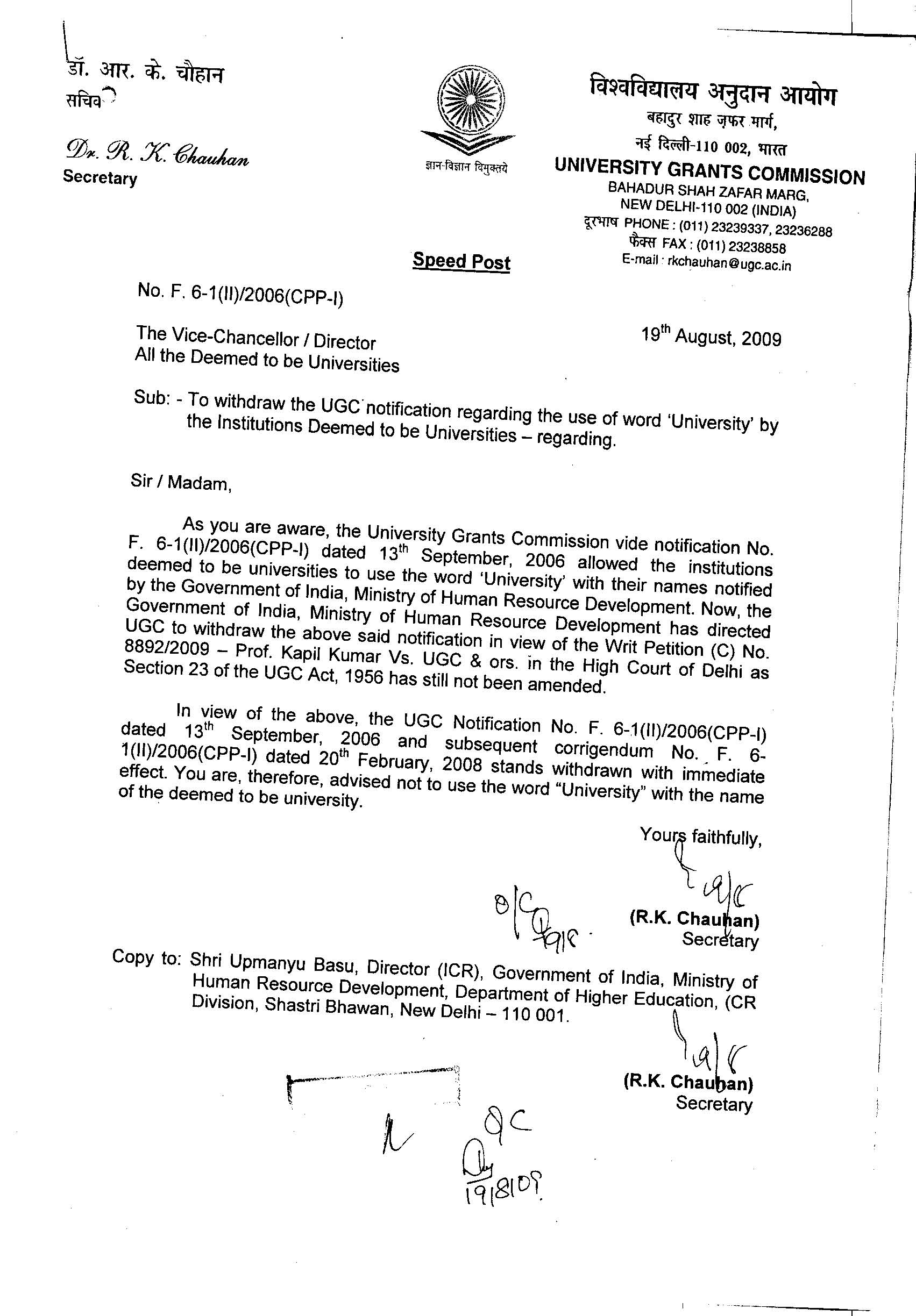
This means KIIT, SOA and other institutions deemed to be universities should no longer be using the word ‘University’ in their name. Also, it validates our earlier effort to convince the people pushing to make UCE Burla a deemed university to go for a state university status instead. Not only it was easier to get the state university status (the new deemed to be universities applications are frozen for now), but now VSSUT is a university and unlike KIIT and SOA, VSSUT can use the word ‘university’.
October 3rd, 2009
Following is an excerpt from a report in dnaindia.com.
Jayalakshmi Venugopal / DNA, Thursday, September 10, 2009 9:03 IST
The Planning Commission approved "in principle" plans of the Union ministry of human resources development to establish 20 new Indian Institutes of Information Technology (IIITs) under the 11th Five Year Plan across various locations in India.
The National Association of Software and Services Companies (NASSCOM), the trade body of the IT and BPO sector, was entrusted with the task of preparing a detailed project report (DPR) which would incorporate a model of private-public partnership in the setting up of these new institutes.
This plan, prepared by NASSCOM, was submitted in May 2008, and has now been granted the Planning Commission’s go-ahead.
However, it is still awaiting the green signal from the finance committee of the Union government and the central cabinet.
October 3rd, 2009
Following is an excerpt from an IANS story by Prashant Nanda that we found in a report in thaiinidan.com.
… “We will retain our original name (NIT-Warangal) but it will become an integrated university with both medical and legal education among other programmes beyond engineering and technology.
“We will also provide postgraduate courses in humanities, business economics, biotechnology and many others. The focus will gradually shift to from under-graduation to post-graduation and research,” Rao explained.
NIT Warangal is the first among the NITs. It was dedicated to the nation by the first prime minister Jawaharlal Nehru way back in 1959. Then it was known a regional engineering college. The institute is older than many IITs, including IIT-Delhi.
… The director said the institute, which started its journey with a little over 100 students from a temporary campus, now boasts of 4,200 students. In 2006, the institute had 2,000 students of which 1,600 were pursuing B.Tech courses and the rest M.Tech.
“While all the central government institutes are implementing the OBC (Other Backward Classes) quota in three years, we did it at one go. With an increase in the number of seats, we have shifted our focus to post-graduation and research. Out of 4,200 students, currently 1,400 are M.Tech students and 300 are PhD scholars,” Rao added.
Like the Massachusetts Institute of Technology (MIT) in the US, NIT-Warangal will become an integrated university and provide all kinds of courses to students to help the country move forward in the field of higher education, he said.
“The process of becoming a university will start from the coming academic session but it may take a few years to become a full-fledged one. We are targeting 5,000 students by 2011 and 15,000 by 2015,” Rao said, elaborating on his mega plan.
“We are planning to have the school of medical science next year. We are going to give emphasis on biotechnology and microbiology and here the school of medical science will help us grow in both research and innovation.”
NIT Roukela has recently started a program in Biotechnology and is about to start MBA. But it must go beyond and pursue a medical school.
September 29th, 2009
Some of the first five IITs in Kharagpur, Mumbai, Chennai, Kanpur and Delhi were developed through mentorship by various foreign countries and organizations such as UNESCO. For example, IIT Bombay was helped by UNESCO and Soviet Union, IIT Madras was helped by Germany and IIT Kanpur by a consortium of 9 US universities.
The Union HRD minister Mr. Kapil Sibal seems to be looking for similar help for establishing the 14 innovation universities. Following is an excerpt from a report in Economic Times.
The ministry for human resource development is keen to tie up with the world’s leading universities to ensure that its “innovation universities” are a class apart from the pack. During his visit to the US in late October, the minister for human resource development Kapil Sibal would like to firm up MoUs with leading US universities to collaborate with the proposed innovation universities.
Among the American Universities that are being approached are Yale, Standford and MIT. The government plans to set up 14 innovation universities over the next few years.
The government proposes to set up these universities as “global centres of innovation” and would like to draw on the talent and expertise of leading universities. “We are looking for a collaboration for two or three of the innovation universities,” a senior ministry official said. India has had a history of collaborating with leading international universities to set up her own world class institutions.
… Mr Sibal, who will be travelling to the US ahead of Prime Minister Manmohan Singh’s state visit in November, will leading a delegation to put in place the India-US Education Council.
September 29th, 2009
Following is an excerpt from a blog entry of Professor Giridhar Madras of IISc Bangalore.
… According to the table, for an assistant professor on contract i.e., with no postdoc experience, it would start at 37,000 + accommodation. A regular assistant professor will get 52,000 + accommodation and will move to 62,000 + accommodation after three years. In addition, they are other benefits. This includes telephone allowance, academic allowances, children education allowance, subsidy for single girl child, leave travel concession for the whole family every year,medical benefits to the family, travel money for attending conferences etc.
In addition, one can get fellowships that vary from Rs 60,000 to Rs 6 lakhs per year from DST/DBT, depending on the fellowships. Faculty can go abroad during the three month vacation every year and get paid in international currency. One can take sabbatical for one year every six years and get paid at both places. In addition, one can earn considerably from consultancy from industry (or even government labs) depending on the area they work in.
The blog has more details and pointers to more details on what the IIXs should do to get a clearer picture out to prospective faculty.
September 27th, 2009
Next Posts
Previous Posts



.jpg)



